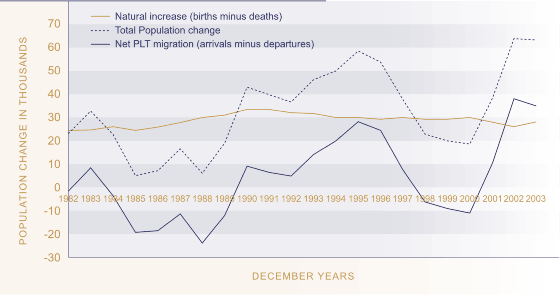Changes in population size are driven by two key factors: natural increase (births minus deaths) and net annual migration.
Births exceeded deaths by 28,100 in the December 2003 year, an increase from 26,000 in 2002. Historically, natural increase has been the main component of population growth in New Zealand, but its contribution is slowly declining as the population ages and fertility declines.
The number of people coming to live in New Zealand in 2003 exceeded those leaving the country to live elsewhere by 34,900, a slightly smaller net migration gain than in 2002 (38,200). In the December 2002 and 2003 years, the net gain from permanent and long-term migration accounted for 60 and 55 percent, respectively, of population growth.
Figure P2 Components of population
change, 1982 to 2003

Source: tatistics New Zealand
Almost 70 percent of New Zealand nationals returning home in 2003 after a long-term absence came from either the United Kingdom or Australia. These two countries were also the most popular destinations for New Zealand citizens departing for a permanent or long-term absence.
The net inflow of non-New Zealand citizens more than doubled between 2000 and 2002 (from 26,600 to 54,900), before falling to 46,100 in 2003. The main contributing countries in 2003 were China (11,300), the United Kingdom (8,400), India (5,500), Japan (2,400), Australia (2,200), Fiji (1,900) and South Africa (1,600). Auckland is the destination of the largest group of new migrants.
